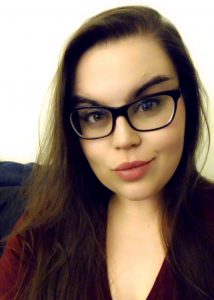She always had an interest in photography but never knew she could make a career out of it. Now, Wright State University photography major Katie Burianek is well on her way.
Her most recent success was her selection for a highly competitive Yeck College Artist Fellowship, an honor that will enable her to display her photos at the Dayton Art Institute.
“Becoming a Yeck Fellow means the world to me,” said Burianek. “I never thought any of my work would actually end up in a museum. So the fact that not only do I get to help young students follow their passion for art, I also get to show my own artwork in the museum is an amazing opportunity.”
The Dayton Art Institute opened as an art school in 1919 and has been called “Dayton’s living room.” The museum’s collections contain more than 26,000 objects spanning 5,000 years. Notable works include those by Monet, Rubens, Degas, O’Keeffe, Hopper and Warhol.
Yeck fellowships are supported by the Yeck Education Endowment Fund, which promotes and enhances the development of promising young artists. In addition to creating a body of museum-class work to be displayed, the fellows are required to teach art to selected high school students from multiple school districts for nine weeks. The college students create their own lesson plans that they feel will help their students the most in growing their artistry.
“I decided to incorporate an abstract photography project that teaches them to view their artwork and objects in multiple ways to open up the possibilities that they may miss from looking at something the same way every time,” said Burianek.
The Dayton Art Institute closed temporarily in March to help prevent the spread of coronavirus, and the final three weeks of classes for the high school students were canceled. But the Yeck fellows continued to meet online to prepare for the exhibition, which has been delayed until the museum reopens.
Growing up in Kettering, Burianek loved looking at wildlife, architecture and landscape photography. At Kettering Fairmont High School, she took photography classes and was able to use a darkroom, which got her into doing photography herself.
Burianek earned her associate degree in graphic design at Sinclair Community College and then transferred to Wright State. She said she was attracted to Wright State because it was affordable, close to home, offered a quality education and the transfer process was easy.
Burianek said Wright State has prepared her to be successful because the projects involve real-world scenarios, and faculty in the Department of Art and Art History teach students things they can apply following graduation. The photography program is special because of great faculty like Tracy Longley-Cook, associate professor in photography, and Ben Montague, associate professor in photography, she said.
“They are so dedicated to all of us growing as artists and pushing ourselves as much as we can. They want us to succeed and are willing to go out of their way to help us in any way that they can,” said Burianek. “We get a lot of one-on-one time with our teachers, and it allows me to learn from them a lot more than if I went to another school with a huge program.”
Longley-Cook said Burianek has demonstrated real talent and curiosity since taking her first photography class with her.
“Her willingness to experiment and discover new ways of exploring photographic processes has been very exciting to witness,” said Longley-Cook. “We will certainly be seeing more success stories from Katie after graduation.”
At Wright State, Burianek got into fine art photography. She says photography enables her to tell a story with a single image.
“Photography is special because it allows you to transport the viewer into a different world based on what you show,” she said. “It could be transporting people to another country because of your landscape photos, a place that they will never be able to see in person. Or it could be into a world of macro where you are seeing details of an object that you would never be able to see with the human eye. So the photos become their experience of it.”


 Wright State University Foundation awards 11 Students First Fund projects
Wright State University Foundation awards 11 Students First Fund projects  Gov. DeWine reappoints Board Treasurer Beth Ferris and names student Ella Vaught to Wright State Board of Trustees
Gov. DeWine reappoints Board Treasurer Beth Ferris and names student Ella Vaught to Wright State Board of Trustees  Joe Gruenberg’s 40-Year support for Wright State celebrated with Honorary Alumnus Award
Joe Gruenberg’s 40-Year support for Wright State celebrated with Honorary Alumnus Award  Wright State’s elementary education program earns A+ rating for math teacher training
Wright State’s elementary education program earns A+ rating for math teacher training  Wright State’s Calamityville hosts its largest joint medical training operation
Wright State’s Calamityville hosts its largest joint medical training operation 